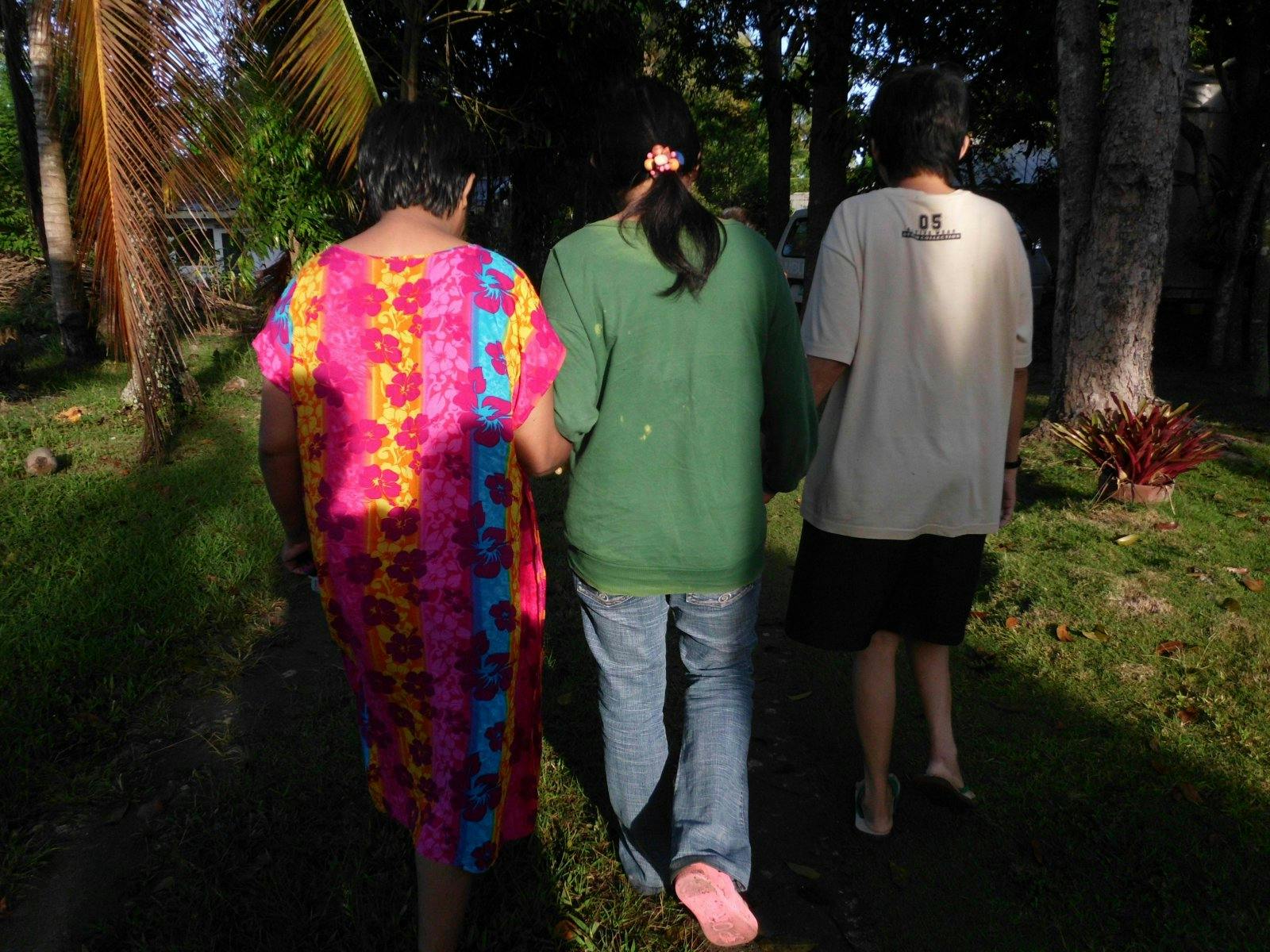Survivors and victims of gender-based violence deserve mental health care services
May 28, 2019
Story

Survivors in recovery take a morning walk together.
A woman, in her 20s, seated at the edge of the concrete bed inside her cell, kept on rocking herself, her hands clasping so tightly the hem of her blouse by her crotch.
A woman in her late 20s, pregnant with her fourth child and fleeing from a wife-beating husband, sits on her hunches, in an almost perpetual vigilant mode.
Two women, both have worked domestic helper in Dubai and Kuwait, respectively; and both had suffered from sexual abuse from their male employers while working abroad, and were beset with inexorable nightmares and anxieties month after their harrowing escape.
I met these women at a residential psychiatric facility in 2013, as I myself was recovering from a mental health crisis. I healed well after a few days of medication but family prevailed to extend my confinement to three months; luckily, two of those inexorably long months were spent outside the locked cell, and I had the relative freedom to roam around. Often I found myself listening to the stories of those who were inside the isolation cells and the recovery rooms, and their stories re-told by their caregivers, who were mostly their own mothers, or other female relatives.
I found out that among those whose mental health problems revolved around psychosis (hallucinations and delusions), are women who are suffering from the consequences of inflicted gender-based violence in its many forms – from bullying to domestic violence to militarization and armed conflict to human trafficking.
And I was aware then that this was just, as the cliche goes, the tip of the massive iceberg, and that while real icebergs are now thawing and calving due to unprecedented climate change-induced global warming, this metaphorical iceberg that is gender-based violence isn’t. The World Health Organization, in its latest Violence and Health Report 2013, released last year, still sees gender-based violence as an intractable global epidemic --- a decade since it released its watershed WHO Report on Violence and Health in 2002.
An earlier report on the prevalence of violence against women (VAW) noted that data suggested that a third of all women worldwide experience violence, and that 30 per cent consists of domestic abuse.
In a resolution recognizing gender-based violence as a public health issue, the Psychological Association of the Philippines (PAP) last year mentioned national data showing that 57 percent of VAW survivors report depression, anxiety, sleeplessness, confusion, feelings of isolation and 16 percent attempted suicide while 38 per cent of victims and survivors do not seek help nor tell anyone. Moreover, PAP noted that less than 10 percent seek professional medical care, and often when the cases had reached extreme crisis levels, like what happened to most of us inside the psychiatric facility.
Before becoming officially a person of lived experience myself, suffering and surviving the cumulative effects of traumas, I was not a stranger to this public health issue of gender-based violence. I had practiced advocacy journalism for years, having been a part of an all-female news agency based in New Delhi, and I had tracked down stories of gender-based violence in communities. In the early noughties, I volunteered as night shift manager of a confidential shelter for battered women for more than a year, and had to deal with vicarious trauma for months after. I had also written about women and children caught in the vise of armed conflicts in parts of Mindanao where two insurgencies engage government troops in clashes in remote villages.
And yet, inside the psychiatric facility I still learned new insights:
One, that gender-based violence had spooked most of those women who sought medical help for their affliction. And they are mostly poor, and the ill-health cuts across age levels -- some were pregnant and others have just given birth; many were young, late teens to early 30s, and a few were crones.
Second, the mental health resources and services for women victims of gender-based violence is scarce in my country. The facility that took us in was maintained by the Roman Catholic Church and managed by nuns. The local government provides a small, almost insignificant subsidy that often comes late. The Department of Health allots only 5 percent of its budget to mental health, and woeful of all, the country has no mentalhealth policy yet.
The Global Violence and Health Report of 2013, released late last year, showed that the Philippines scores big in the areas of policy-making and implementation on some aspects of combatting gender-based violence. In the past 25 years since the Beijing Declaration, there has been at least 10 major national policies and a host of local ordinances to combat many forms of GBV, like human trafficking, rape and domestic abuse, child marriage, school bullying. It also has implemented large-scale campaigns to change societal norms.
But the Philippines suffers from one wide gap. No, a chasm, an abyss. My country does not have a national plan /program nor policy for providing mental health services to victims and survivors of GBV. I have taken a look at other countries in the report if only to confirm that it lags behind other countries in Asia and the West Pacific. The Philippines alone does not have a mental health policy yet. Malaysia, Indonesia, Thailand,, Singapore, Cambodia, Vietnam already have mental health policies and services for victims of violence. Malaysia had implemented its policy as early as 2002 and by 2006, has implemented a community-based program that includes livelihood and anti-stigma campaigns.
There had been several attempts to pass a mental health policy in the past Congresses. A multi-sectoral draft sponsored by medical practitioners might endure legislative scrutiny and be passed within the decade. I have joined the campaign to pass the mental health bill and urged others to do the same. I have signed the petition at change.org to muster awareness of mental health issues and the need for a national mental health policy. But the campaign has been slow in gathering signatures, an indication of how little the interest and awareness of the populace on the importance of such a policy.
I am also lending a hand in organizing mental health advocates in the city, making sure that persons with lived experience like us are represented and being heard within the group. I am also working with fellow sufferers to create a peer support group that will enable us to advocate for mental health rights, be informed about medications and talk therapies, and take the steps to join forces with media and non-government organizations in eliminating stigma and discrimination against GBV survivors who have mental health issues.
Lastly, I support the global campaign to include mental health among the agenda of the post-2015 Sustainable Development Goals to be determined in September this year. I am convinced that mental health is an issue with cross-cutting impact across many other development-oriental goals such as peace and security (including an end to gender-based violence), inclusive education, improved nutrition and health of mothers and children, as well as access to human rights.
I still think of GBV as an iceberg, and yet as I think of how it is being combatted at many fronts, I am reminded of the reflection of the psychotherapist, Lillian Rubin in her book, The Man With the Beautiful Voice, who described the breaking of a piece off an iceberg in Glacier Bay, Alaska:
“Calving, the process is called, a term that fascinated me. Why use the language of birth when something is lost? Then I realized as the days passed, loss is not the only thing that happens in calving, since along with its new shape, the iceberg takes on a new identity to those who are trained to see it.”
All these efforts, mine as well as that of others everywhere and anywhere, to chip away at the vast, cold and impassive floating frozen behemoth that is GBV, allows the cracking of pieces, the calving, so that through time, it gets smaller, a changed piece of a problem that would soon thaw into its ultimate (re)solution.




